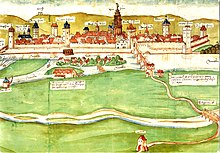Mill jam
A mill dam is a barrage in a flowing water , created for pre- or early industrial forms of hydropower use .
Pre and early industrial use of hydropower
Before one could conduct energy in the form of electricity over any distance to the place of its application, there were a multitude of water mills . Besides grain mills , there were (and are) sawmills as water-powered saws. In addition, labor-intensive work in metallurgy was carried out with water wheels, copper hammers , but also hammer mills for steel production . Such uses of hydropower are basically also possible without a weir with undershot water wheels. In large bodies of water, problems of changing water levels were often solved with the help of ship mills , in which the water wheel and the machine it propelled were installed on a fixedly anchored ship. A more constant water level, a locally faster current and the operation of overshot and medium- sized water wheels could only be achieved with the help of a weir .
Conflicts and Regulations
In times of underdeveloped lock technology, barrages represented a considerable hindrance to shipping. Where the gradient was low and the river valley was very flat and wide, there were also unpleasant rises in the water level and areas that did not belong to the mill operator were flooded. That is why the installation of a mill jam required the sovereign permission, which in times of feudalism mostly had to be paid for with taxes from the mill.
An outstanding example of the sovereign permission is the imperial Neckar privilege of the city of Heilbronn to dam and obstruct the Neckar . For centuries it made Heilbronn the upper end point of Neckar shipping. An outstanding example of the backwater is the Havel , whose water level was raised by around one meter in Spandau, 50 km away, due to the flood of mills in the city of Brandenburg .
Effects on landscape development
Some wetlands , which today appear as primeval landscapes, were possibly cultivated land before they were (re) watered by medieval windmills. The great time of the mill dams was at the same time the time of the least forest and the most extensive arable land in Central Europe and thus the greatest soil erosion . Since the sediment load of the rivers settled mainly in the backwater of the weirs, the level of the river bed was raised here.

